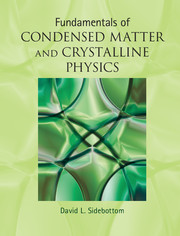 Fundamentals of Condensed Matter and Crystalline Physics
Fundamentals of Condensed Matter and Crystalline Physics Book contents
16 - Percolation theory
from Part IV - Transitions
Published online by Cambridge University Press: 05 August 2012
Summary
Introduction
Percolation theory refers to properties of a simple experiment in which random events produce features common to second-order transitions; namely a continuously developing order parameter and self-similar, critical-like fluctuations. The model itself is quite simple, yet as we will see, it has been used extensively to interpret many phenomena found in nature, including not only the conditions under which liquids percolate through sand (from which the theory obtains its name), but also the manner in which stars form in spiral galaxies.
In this chapter, we investigate the percolation process in some rigorous detail to demonstrate how percolation clusters develop in a self-similar, power law manner near the percolation threshold. We also take this opportunity to introduce both the finite-sized scaling and renormalization techniques. Both of these techniques exploit the inherent self-similarity to gain insight into the critical exponents that characterize a second-order phase transition, and will prove useful to us in the next chapter.
The percolation scenario
At the heart of percolation theory is the question of how long-range connections develop through a random process. Consider a geometrical lattice of some arbitrary dimension such as the two-dimensional networks of pipes shown in the form of a square lattice in Fig. 16.1a. Here, the pipes are fully connected and fluid is free to flow from one edge of the network to the other. Suppose we now insert valves throughout this arrangement of pipes in one or the other of two ways. In the first instance, which corresponds to bond percolation, the valves are placed inside the pipes (i.e. inside the “bonds” between intersections), as shown in Fig. 16.1b. In the alternate case, referred to as site percolation, the valves are placed at the intersection of the pipes. Again, when all the valves are opened, the network is fully connected and fluid can flow readily from one side to the other. But, if all the valves are closed, the network is fully unconnected and fluid is unable to flow anywhere.
- Type
- Chapter
- Information
- Fundamentals of Condensed Matter and Crystalline PhysicsAn Introduction for Students of Physics and Materials Science, pp. 289 - 312Publisher: Cambridge University PressPrint publication year: 2012


